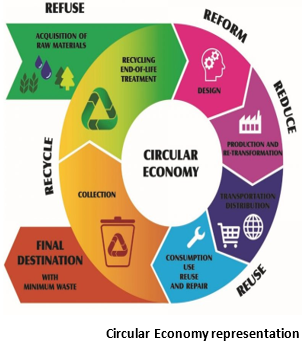- Courses
- GS Full Course 1 Year
- GS Full Course 2 Year
- GS Full Course 3 Year
- GS Full Course Till Selection
- Online Program
- GS Recorded Course
- NCERT (Recorded 500+ Hours)
- Polity Recorded Course
- Geography Recorded Course
- Economy Recorded Course
- AMAC Recorded Course
- Modern India, Post Independence & World History
- Environment Recoded Course
- Governance Recoded Course
- Science & Tech. Recoded Course
- International Relations and Internal Security Recorded Course
- Disaster Management Module Course
- Ethics Recoded Course
- Essay Recoded Course
- Current Affairs Recoded Course
- CSAT
- 5 LAYERED ARJUNA Mentorship
- Public Administration Optional
- ABOUT US
- OUR TOPPERS
- TEST SERIES
- FREE STUDY MATERIAL
- VIDEOS
- CONTACT US
National Circular Economy Roadmap For Plastic Reduction
National Circular Economy Roadmap For Plastic Reduction
Context: In December 2023, a flagship document on ‘National Circular Economy Roadmap for reduction of Plastic waste in India’ was released.
What is this roadmap?
- This roadmap is a joint effort between research institutions in India and Australia.
- Aim: to encourage collaboration in research and industry. Main focus on creating a plan for India to shift towards a circular economy in the plastics sector.
|
What is Circular Economy? A circular economy is a way of producing and consuming goods that focuses on sharing, leasing, reusing, repairing, refurbishing, and recycling materials and products for as long as possible. It aims to extend the life cycle of products. When a product reaches the end of its life, its materials are recycled and used again, creating additional value. It promotes sustainability and waste reduction. |
Why do we need a roadmap for plastic waste?
-
Plastic poses a major challenge in the 21st century. India produces around 26,000 tonnes of plastic waste daily, totaling approx 4 million tonnes annually.
-
Packaging is the largest contributor (59%), followed by building (13%) and agriculture (9%).
-
Waste management in India is fragmented in the informal sector.
-
The government's July 2022 ban on single-use plastics only applies to a small portion (10-15%) of plastic usage.
Benefits of Circular Economy:
1.Economic Benefits: it opens new markets for used plastics and promotes eco-friendly products.
2.Environment Benefits: Reducing landfill waste, less greenhouse gas emissions, improved air quality, and less microplastics in the food chain.
3.Behavioral Change: encourages a shift from 'use and throw’ attitude.
4.Global Commitments: it supports Sustainable Development Goals (SDGs) and the net-zero target.
5.Plastic Treaty and Global Initiatives: supports Global Plastics Treaty, LiFE (Lifestyle for the Environment) movement etc.
Challenges in Attaining Circular Economy |
Solutions |
|
1. Lack of Awareness |
More awareness campaigns and educational programs. |
|
2. Less facilities for recycling and reusing materials |
Develop infrastructure for waste collection, recycling, and processing. |
|
3. Initial economic costs are high |
Introduce incentives, subsidies, or tax benefits to adopt circular economy practices. |
|
4. Consumer Behavior of 'use and throw' |
Promote sustainable consumption for environmentally friendly choices. |
|
5. Lack of clear rules and non-strict implementation |
Enforce regulations strictly and give penalties. |
|
6. Outdated technologies for recycling |
Invest in research and development |
|
8. Resistance to Change from businesses or individuals |
Provide support and guidance and highlight long term benefits. |
Plastic waste management in India
-
Implementation of state-specific bans on single-use plastics.
-
Adoption of Extended Producer Responsibility (EPR) to hold producers responsible for proper disposal of plastic products.
-
Notification of Plastic Waste Management Rules, which provide guidelines for plastic waste collection, segregation, and recycling.
-
Establishment of waste-to-energy plants to convert plastic waste into energy.



